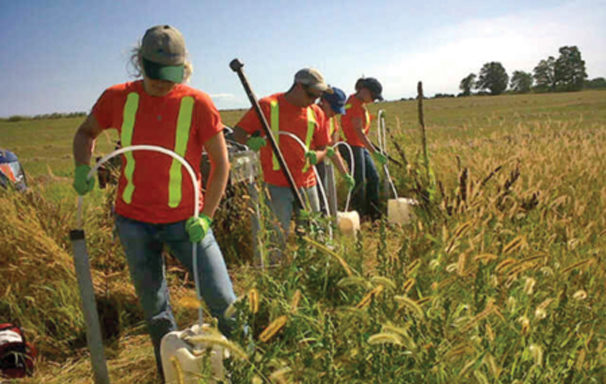
Monitoring Groundwater
What is the project monitoring?
- Groundwater quality, levels and flow direction at the long-term waste management facility and at other major cleanup sites
- Drainage water quality and volume at the long-term waste management facility site
Why is the project monitoring groundwater?
- To ensure measures to protect and improve groundwater are effective
What measures is the project taking to protect groundwater?
- Isolate the waste from the groundwater environment by constructing a multi-layered, engineered aboveground mound
- Limit the depth of excavation at clean-up sites to above the groundwater table, whenever possible
- Pump out groundwater accumulation in excavations, analyze and treat, if necessary, prior to discharge
How is the project monitoring groundwater?
- Determine groundwater levels and flow direction from a network of monitoring wells within the site of the long-term waste management facility and at other major cleanup sites
- Measure volume of treated groundwater pumped to Lake Ontario from the long-term waste management facility
- Collect and analyze water samples for radiological and non-radiological contaminants from new and existing monitoring wells within the long-term waste management facility and at other major cleanup sites
- Collect and analyze drainage water samples at the long-term waste management facility
- Determine changes to groundwater flow patterns in the vicinity of the long-term waste management facility and Brand Creek through groundwater elevation contour mapping
- Continue groundwater flow and water quality sampling at the long-term waste management facility and at other major cleanup sites following completion of the Project
Monitoring Surface Soil Quality
What is the project monitoring?
- Contaminant concentrations in surface soil (radiological and non-radiological) at the boundary of major work sites to monitor for wind-blown dust
Why is the project monitoring surface soil quality?
- To ensure measures to prevent dust from leaving work sites are effective
What measures is the project taking to protect surface soil quality?
- Reduce airborne dust and its deposition by minimizing exposed excavation surfaces, moistening soil and using other dust mitigation measures (see Air Quality panel)
- Limit the maximum distance equipment travels over waste at the long-term waste management facility to 50 m to reduce airborne dust
- Erect control structures around work areas to prevent surface water and groundwater from flowing into or away from clean-up sites
How is the project monitoring surface soil quality?
- Sample and analyze surface soil for radiological (thorium-230, etc.) and non-radiological (heavy metals) contaminants at the boundaries of the long-term waste management facility and the Highland Drive area cleanup sites to monitor for wind-blown dust
Soil quality and clean-up criteria
During the cleanup, another kind of soil quality monitoring, called verification, will be done. This will confirm that sites contaminated with low-level radioactive waste have been cleaned up to the required Cleanup Criteria. Verification is how the Project will determine when a property is clean.
Once contaminated soil has been removed from a property, soil samples will be collected and analyzed to verify the criteria have been met. Property owners will then be provided with a letter to confirm the cleanup of their property has been successfully completed.
